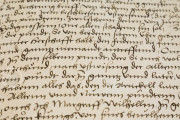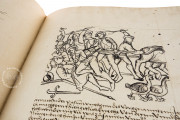The Swiss Chronicle of Wernher Schodoler ranks among the most important Swiss illuminated chronicles. It is composed of three volumes and, due to its illustrations, is considered an important document of the time preceding the battle of Marignan. While the great chronicles of the time continued in the medieval tradition, Schodoler’s chronicle paved the way for a new epoch: the Renaissance.
The Annalist — Wernher Schodoler
Wernher Schodoler was born in 1490 at Bremgarten on the Reuss in Switzerland, hometown of his ancestors for centuries. The annalist and his family ranked among the most prestigious citizens of the town. His grandfather and father had been directing the affairs of the town as mayors.
In the first decade of the 16th century, Schodoler worked as a clerk in the chancellery of Bern, where he gained insights into the politics of this capital city of the Swiss Confederation and also into the famous chronicles preserved there. Back in his hometown, Schodoler started a successful career.
He held the highest positions in Bremgarten up to his tragic death in 1541, when he died from the plague. We do not know what motivated the busy town clerk, who even participated in several war campaigns, to write such a comprehensive chronicle on his own initiative. The fact that it is the only chronicle from a subdued area makes it an all the more important document.
Based on Old Recounts of an Eventful History
Most of Schodoler’s work is based on other contemporary chronicles, among them the Official Chronicle of Bern by Diebold Schilling. He took a very critical approach to the text, added different comments to certain events, cut out, or added lines to certain passages of the text which did not seem to fit within the overall image he wanted to convey.
He had his own opinion on things and the courage to be articulate. The chronicle also contains some of Schodoler’s own texts; some passages have become famous, like the description of the battle of Marignano in which Schodoler took part himself.
Both pictures and texts deal with state events and warfare but also with everyday life, thus making the chronicle an important and comprehensive source for anyone who is interested in history.
The Three Volumes
The first volume treats the history of the Confederation up until the Council of Constance (1415). The text is written in Gothic handwriting. Despite initial plans to add illustrations to the text, and for which the copyist had even reserved some space, these were never added.
New sections are introduced by colorful initial letters and decorated with rinceaux. The second volume deals essentially with the old Zurich war. With the exception of some paragraphs written by Schodoler himself, it is based on Etterlin, on Schilling’s Bern Chronicle and the Zurich Chronicle.
The volume is decorated with 130 colored pen drawings as well as with colored and gold-plated initials. The illustrations of this volume, which were related to Schodoler and two other artists, create a very special atmosphere.
The medieval vision of the world of other ancient Swiss illuminated chronicles has now made room for a new feeling of life and space. The pictures betray a great delight in observation and quality compositions. The third volume describes a few conflicts, among which the Burgundian and Italian wars.
Also in this case Schodoler’s work is based on Etterlin and on the Bern Chronicle by Diebold Schilling. The third volume contains 196 pen drawings in sepia, all from the hand of an anonymous artist. His compositions outdo by far the work of former chronicle illustrators.
The landscapes show new perspectives of vastness and depth. The gestures of the depicted human beings betray the feeling of the Renaissance. The pictorial language of Wernher Schodoler’s chronicle makes it a typical document of the time and a testimony of the then-popular type of man which united the fighter and the artist in one person.
We have 1 facsimile edition of the manuscript "Swiss Chronicle of Wernher Schodoler": Eidgenössische Chronik des Wernher Schodoler facsimile edition, published by Faksimile Verlag, 1983
Request Info / Price

























